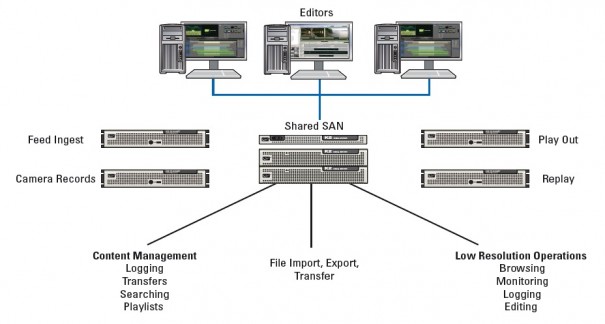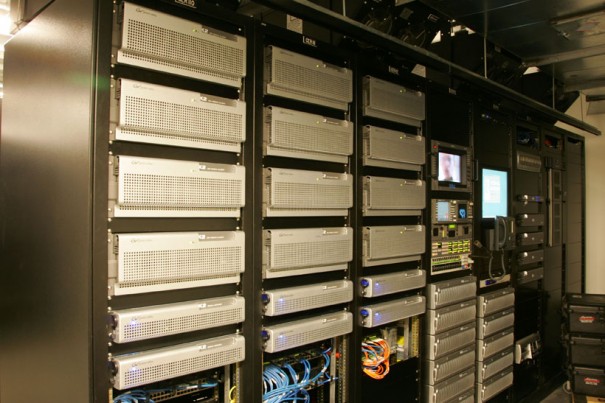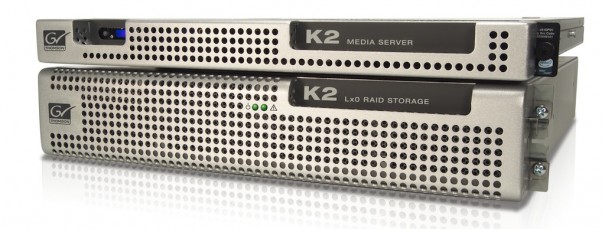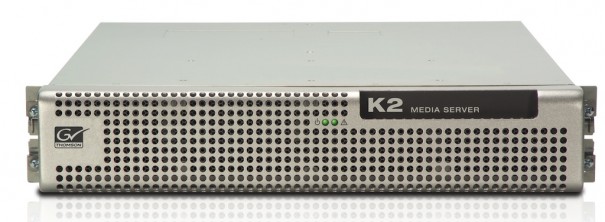¿Qué tener en cuenta al elegir un servidor de media?
Un servidor de media es un sistema mucho más complejo de lo que uno podría pensar al inicio. Al elegir un sistema para una instalación, hay un amplio número de cuestiones que deben ser consideradas cuidadosamente. Matt Allard, Director Senior, Marketing de Soluciones, en Grass Valley, analiza en esta Tribuna algunos aspectos clave que, desde su punto de vista, hay que tener muy en cuenta a la hora de elegir un servidor de media.
Los mejores servidores de media de hoy en día aprovechan las tecnologías básicas de la industria de TI general, y luego optimizan y mejoran esas tecnologías específicamente para los requisitos de tiempo real y alta disponibilidad de broadcast televisivo y producción de vídeo. Los mejores proveedores construyen sistemas que utilizan sistemas de archivos estándar, almacenamiento y redes.
Estos proveedores ofrecen un valor añadido mediante optimización y ajuste de las tecnologías de TI para aplicaciones de media en formas en que los proveedores de TI no pueden o no harían. La implementación de la última tecnología produce más soluciones rentables.
Un servidor de media debe incorporar una variedad de las últimas tecnologías. Esto incluye redes troncales de fibra de 8 Gb con discos SAS de 15/7.2K en la topología de RAID-5 o RAID-6. Los componentes de almacenamiento por sí solos no proporcionarán una solución satisfactoria, sino que también deben estar integrados con una completa infraestructura. Un componente del servidor de TI debe estar incluido para actuar como un puente de datos y gestionar los requisitos de ancho de banda dinámicos y determinísticos. Para un óptimo rendimiento, son convenientes un sistema operativo de 64 bits y sistema de archivos. Una manera de proporcionar la escalabilidad y la rentabilidad es adaptar el protocolo iSCSI sobre 10 Gb/1 Gb Ethernet para proporcionar un rendimiento determinístico y en tiempo real para el movimiento de media.
Las tecnologías e infraestructura deben ser combinadas para controlar el ancho de banda. El ancho de banda es un factor primario para determinar la fiabilidad con que funcionará un sistema y qué capacidades puede proporcionar. Un sistema de servidor debe ser diseñado para gestionar los múltiples niveles de ancho de banda que pueden ser necesarios para operaciones determinísticas. Esto puede ser proporcionado por un sistema de archivos compartidos que incluye mecanismos de Calidad de Servicio.
Tres niveles de ancho de banda deben ser gestionados:
• El primer nivel con prioridad más alta es para la media en tiempo real donde los clientes están diseñados para nunca exceder los anchos de banda fijados. Este rendimiento en tiempo real es un nivel de servicio no necesitado por la mayoría de sistemas de TI regulares.
• En el otro extremo del espectro tenemos el ancho de banda compartido gestionado para operaciones que no son en tiempo real, tales como transferencias de archivos.
• Entre estos dos niveles también debería haber un nivel de ancho de banda reservado para las
actividades de producción en tiempo crítico, tales como la edición, donde a cada cliente individual se le asigna un ancho de banda que no se puede exceder.
Los tres niveles deben estar disponibles al mismo tiempo. En muchos sistemas sólo hay un nivel de gestión de ancho de banda y no se puede depender de él para realizar todas las tareas de forma fiable y consistente.
Un sistema de servidor de media apropiado tiene redundancia integrada, buffering, y múltiples niveles de procesadores para rendimiento garantizado. El proveedor de dicho sistema caracteriza el desempeño de almacenamiento para varios usos de producción, y mide el rendimiento de ancho de banda por LUNs, servidores y controladores individuales.
Otro aspecto único de los servidores de media es la gestión de archivos. A diferencia de los archivos encontrados en la mayoría de los sistemas de servidor de TI habituales, los archivos de servidores de media son grandes … muy grandes. El sistema, incluidos los controladores de almacenamiento y sistema de archivos, deben estar especialmente ajustados para este tipo de archivos.
En un sistema de servidor estándar de TI existe un gran número de archivos pequeños, sencillos, con una rápida lectura/escritura y desde el almacenamiento. No es necesario leer durante el proceso de escritura; los retrasos y las latencias se pueden tolerar.
En la media, los retrasos y las latencias no son aceptables, ya que se traducen en marcos de color negro y pérdidas de sonido. En la media, trabajar con archivos de gran tamaño significa que el almacenamiento tiene muchas lecturas simultáneas durante el proceso de escritura.
Para una adecuada gestión de archivos de media, el sistema del servidor debe proporcionar buffering y prebúsqueda especializados, y mayor corrección de errores sobre la marcha, empaqueteamiento de contenedores de archivos de media de contenido multi-pista y optimización de la capa de aplicación para lectura/escritura de manera eficiente y determinista. Al evaluar un sistema de servidor para la producción de media, esta es un área que debe ser examinada de manera muy crítica.
Muchos sistemas que dicen ser adecuados para media no ofrecen estas optimizaciones, y por lo tanto no están a la altura de ofrecer el desempeño constante necesario para la entrega de contenido.
Flexibilidad de plataforma
Un servidor de media debe ser versátil para que pueda ofrecer soluciones diferentes adaptadas a una variedad de requisitos únicos. Necesita escalar a cualquier dimensión de desempeño y redundancia. La capacidad de expansión necesita escalar hacia vectores múltiples e independientes. Un sistema puede necesitar aumentar los canales de media, capacidad de almacenamiento, ancho de banda de transferencia de archivos, o ancho de banda operacional para necesidades de producción tales como la reproducción y edición en velocidad variable.
Un servidor para broadcast y producción de vídeo debe ser igualmente hábil como servidor de media y como servidor de archivos.
Al no haber segundos intentos durante la entrega de datos de media, la redundancia en múltiples niveles es necesaria. El sistema debe proveer rutas de datos redundantes entre los clientes de media, servidores de media, y el almacenamiento, un diseño que en sí no tenga un solo punto de fallo. En términos de implementación, significa que las prácticas específicas, tales como los controladores RAID redundantes, controladores redundantes de interfaz de red conectados a través de múltiples servidores y conmutadores deben estar disponibles. En un nivel de dispositivos, debe haber fuentes de alimentación redundantes, refrigeración redundante y unidades de almacenamiento redundantes.
Para interconectar la media, un PC estándar con algunas tarjetas de procesador simplemente no es confiable o lo suficientemente robusto. Para proporcionar un servicio de reproducción y grabación de gran disponibilidad para entornos 24/7 debe utilizarse un dispositivo para broadcast y producción, construido para tal efecto, que incorpore tecnologías TI seleccionadas.
Con este enfoque, se puede lograr una variedad de beneficios. El dispositivo puede ser reforzado para su uso incluso en entornos móviles. Los componentes modulares permiten fácil acceso y servicio. Un dispositivo dedicado puede utilizar sistemas operativos especializados incorporados y en tiempo real, junto con procesadores personalizados multi-nivel y de propósito general para ofrecer características únicas y complejas, con un rendimiento fiable. Algunas de estas características incluyen canales multi-propósito que pueden gestionar grabaciones de audio/vídeo, emisión de audio/ vídeo, grabación de súper cámara lenta, grabación y emisión de 3D de ojo izquierdo/ojo derecho combinado, grabación y emisión de vídeo/key combinado, formatos de compresión múltiple, y resolución de conversión superior/inferior/cruzada.
Todo esto se puede aumentar con la creación y gestión de media de proxy de baja resolución. Al mismo tiempo, este tipo de dispositivo incorpora todas las ventajas de una plataforma estándar de almacenamiento, interfaz de control, gráficos y conectividad de red para facilitar la integración y reducir los costos.
Una parte integral de cualquier sistema de servidor de media es el almacenamiento. Los entornos de broadcast y producción tienen diversas necesidades, por lo que un sistema de servidor debe ofrecer una gama de soluciones de almacenamiento.
La implementación más sencilla es de unidades SCSI (SAS) conectadas en serie que se colocan internamente al cliente de media. Para simplemente aumentar la capacidad, el chasis RAID externo con unidades SCSI conectadas en serie puede ser conectado al cliente de media a través de un adaptador de bus host.
Para obtener el mayor rendimiento y flexibilidad, un servidor de media debe apoyar a una red de área de almacenamiento (SAN). Una SAN es una red de almacenamiento dedicada que proporciona acceso a un almacenamiento consolidado. Los dispositivos de almacenamiento en red son accesibles a los servidores de tal manera que parece como si estuvieran conectados localmente en el sistema operativo, permitiendo solicitudes directas de lectura/escritura a los discos de almacenamiento.
El componente de servidor actúa como un puente entre la Ethernet y la conectividad Fibre Channel. También es sede de un sistema de archivos compartidos para proporcionar una abstracción de archivos con la que pueden interactuar las aplicaciones y las redes. Una SAN proporciona la escalabilidad, conectividad, ancho de banda y el almacenamiento para permitir una amplia gama de escenarios de producción.
Como una plataforma de servidor proporciona la infraestructura esencial para la producción basada en archivos, hay una serie de características que se deben proporcionar para que la interoperabilidad sea fácil y eficiente. Los archivos deben ser almacenados como flujos elementales en el disco para la edición directa y operaciones de metadatos. Debe haber importación y exportación de media en paralelo con otras operaciones de almacenamiento en red, soportes extraíbles, editores y archivo. Los archivos de media deben soportar los formatos de compresión de vídeo estándar tales como MPEG-2, MPEG-4, DV, y AVC-Intra. Estos archivos deben estar disponibles para el intercambio en envolturas comunes, tales como MXF y QuickTime.
Otros tipos de archivos, tales como WAV para audio, QuickTime 32 para gráficos y de flujo para vídeo de transporte/programa de MPEG también deben ser compatibles. Los archivos deben ser transferibles utilizando protocolos FTP estándar y CIFS, así como a través de conexiones iSCSI directas. Para ayudar a automatizar el proceso de mover archivos, debe haber servicios de carpeta de supervisión para llevar los archivos dentro y fuera de la plataforma del servidor.
Como los propietarios de contenido desean reutilizar material, la creación, guardado, e intercambio de metadatos deben ser asociados y gestionados con los archivos de media por el sistema del servidor usando un estándar abierto, tal como XML.
La gestión del sistema del servidor y sus capacidades, así como el mantenimiento de costos de operación y el costo total de propiedad bajos deben ser previstos.
Para simplificar la utilización y mantenimiento de los sistemas, debe haber un conjunto de herramientas integradas y utilidades para ayudar a implementar, mantener, configurar y actualizar el sistema.
Integración de aplicaciones
Un sistema de servidor es tan útil e interesante como las aplicaciones con las que puede ser utilizado. Para tener soluciones completas, un proveedor de servidor también debe habilitar aplicaciones que la gente necesita usar. Deben ser aplicaciones que permitan a las personas a utilizar un sistema de servidor para flujos de trabajo de producción en vivo, noticias, entretenimiento, y emisión. Un proveedor de sistemas de servidor necesita crear aplicaciones que permitan soluciones innovadoras y asequibles.
Algunas de estas aplicaciones incluyen la ingesta, repetición, almacenamiento de vídeo, edición, control de canales, y emisión. Los servicios de aplicación deben siempre ofrecer operaciones de proxy, listas/listas de reproducción de decisión de edición comunes, palabras clave de metadatos comunes y marcadores, y gestión de contenido. Tener estas aplicaciones disponibles muestra que el proveedor entiende los detalles de la complejidad que deben tener las soluciones necesarias para trabajar a través de la infraestructura total de broadcast.
La experiencia del usuario y los comentarios son lo que debe impulsar el diseño de las aplicaciones. Las solicitudes deben centrarse en la reducción de las curvas de aprendizaje y en hacer sencillo su uso. La facilidad de uso también debe aplicarse a las actualizaciones y mantenimiento. Todas las aplicaciones deben tener interfaces de usuario y terminología comunes. Deben compartir compatibilidad de formato de archivos comunes, proxy, metadatos e información de lista/lista de reproducción de decisión de edición.
Ningún proveedor de servidor de media puede producir todas las aplicaciones que podrían ser necesarias para los usuarios de producción. Por lo tanto, es necesario contar con una API disponible para que otras aplicaciones puedan ser desarrolladas por terceras empresas e incluso usuarios finales. La API debería soportar entornos de programación comunes que no requieran de lenguajes propietarios.
La capacidad tradicional de una API es para el control del canal de media. Con la transición a la producción basada en archivos, la API también debe incorporar las capacidades de gestión de contenidos. La API debe proporcionar acceso directo a los activos de media. Se debería poder acceder a través de servicios de red para todo el sistema de activos con la capacidad de iniciar la transferencia de archivos a través de protocolos FTP y CIFS. Todas las nuevas funcionalidades se deben soportar abiertamente a través de la API. Para crear estructuras de aplicación sofisticados, debe haber una API que soporte una capa de abstracción de arquitectura orientada a servicios (SOA) para proporcionar servicios de gestión de contenidos, proxy, ingesta, emisión, búsqueda, transferencia y metadatos.
Con una API bien ejecutada, un proveedor de servidor de media debe tener un equipo de ingenieros de soporte de desarrollo para fomentar una comunidad diversa de desarrolladores activos. Ellos ayudarán a que el proveedor desarrolle una amplia gama de aplicaciones de soporte.
Test y Validación
Para que un servidor de media ofrezca todas estas funciones e integraciones, debe realizarse una extensa labor de investigación y desarrollo mucho antes de que cualquier solución sea entregada. Si bien se prevé el desarrollo de software cuidadoso y el diseño de hardware a nivel de ingeniería, hay algunos otros procesos técnicos críticos que deben ser incorporados también.
Con el objetivo de tener una estrecha integración de una variedad de componentes y subsistemas de TI estándar, tiene que realizarse una validación rigurosa.
Algunos de los criterios de evaluación de tecnología que deben ser incluidos como parte de la validación:
• ¿Una determinada tecnología cumple lo que promete en sus características y especificaciones?
• ¿La tecnología puede ser utilizada eficazmente para la aplicación prevista?
• ¿La tecnología puede funcionar también como un pilar fundamental para todo el sistema?
• ¿El ciclo de desarrollo para integrar la tecnología será predecible?
• ¿La tecnología escalará como se esperaba y operará bajo diferentes cargas?
• ¿Cuál será el comportamiento operacional en condiciones de error?
Algunos de los criterios de evaluación para la validación de almacenamiento deben incluir:
• Evaluación comparativa de rendimiento por varios días durante las reconstrucciones, y durante la ejecución de diversas configuraciones de entrada y salida de servidor
• Precio comparado a rendimiento comparado a latencia
• Latencia delimitada con sub-sistemas de almacenamiento aumentado que respondan en un plazo determinado
• Controladores de almacenamiento de intercambio a plena carga, actualizaciones de firmware en directo a plena carga
Algunos de los criterios de evaluación para la validación del sistema de archivos deben incluir:
• Con una SAN compartida, ¿cómo es gestionado y controlado el acceso para el acceso simultáneo de
aplicaciones de tiempo real y no real?
• Gestión automática del perfil del sistema de archivos para que la desfragmentación no sea requerida, incluso en funcionamiento 24/7
Algunos de los criterios de evaluación para validación de movimiento de datos de red validación deben incluir:
• Gestión de las pilas y estructuras de datos de red, de manera que las transferencias sean efectivamente sin pérdidas
• Caracterización, configuración y gestión de los iniciadores y objetivos de los dispositivos, tarjetas de interfaz de red, y conmutadores de red para que funcionen como una conexión limpia sin pérdidas limpia de extremo a extremo
• Análisis de la arquitectura interna del conmutador de red, configuración de puertos, y versiones de microcódigo
Una vez que un diseño ha sido completado y el software creado, debe completarse una validación de componente/ sistema multi-etapa y el proceso de test. Este proceso debe ser implementado sobre una base a largo plazo y ser muy escalable. Para apoyo continuado y nuevas versiones, la funcionalidad y el comportamiento de cada pieza de la tecnología, y de todo el sistema, debe haber tests de regresión extensos.
A medida que avanza la tecnología, habrá generaciones siguientes de componentes. A medida que se incorporan, el sistema debe ser testado de nuevo con las versiones nuevas de las unidades de almacenamiento, controladores RAID, sistema de archivos, servidores de datos, tarjetas de interfaz de red, adaptadores de bus host, y conmutadores, para asegurar que el sistema se comporta como está especificado.
Para poner el esfuerzo necesario en perspectiva aquí hay algunos ejemplos de lo que normalmente se debe hacer con cada generación de componentes para garantizar el funcionamiento del sistema.
– Almacenamiento RAID:
Seis meses con dos ingenieros en el proveedor del sistema de servidor de media y tres ingenieros en el suministrador para validar. Tres meses para versión de firmware, tests de regresión, control de calidad, análisis de las herramientas de configuración.
– Series de unidades de almacenamiento compartido:
De cuatro a seis meses con dos ingenieros para desarrollar el firmware, validación y test. Parte de la validación es para facilidad de servicio extendida para varios años, así el almacenamiento se puede ampliar con futuras generaciones de unidades y tener las unidades, los grupos de unidades, reconstruye todo el trabajo dentro de los niveles de rendimiento previstos.
– Series de unidades internas:
De cuatro a seis meses con dos ingenieros para desarrollar de firmware, validación y test. Análisis de rendimiento y validación, análisis de fallas, manejo especial de modo página para el uso de media, integración de herramientas de gestión y de facilidad de servicio. Al igual que con las unidades compartidas, no todas las familias de unidades o proveedores de unidades cumplen con los estándares necesarios.
– Redes de Media:
Después de años del desarrollo inicial, nueve meses con tres ingenieros para desarrollar las últimas herramientas de redes de media basadas en 10 Gigabit, evaluación comparativa de rendimiento, análisis de fallas, requisitos de proveedor, e integración. Seis meses de tests de liberación, la escala y el análisis de la herramienta de configuración.
Servicios y soporte
Después que un servidor de medios ha sido seleccionado, la interacción con el proveedor tiene que
entrar en una nueva fase. Ahora, el proveedor deberá implementar experiencia en servicios para diseñar e implementar efectivamente un sistema que satisfaga sus necesidades empresariales, y que apoye el sistema de manera eficiente durante su vida útil. La evaluación de las capacidades de los proveedores en estas áreas es esencial para percibir los beneficios de la nueva tecnología, minimizando el riesgo y controlando el coste total de propiedad.
El diseño de un sistema eficaz es esencial para percibir todos los beneficios de la tecnología de
servidor de media. En este paso, los arquitectos de sistema del proveedor deben participar en un proceso de descubrimiento para reunir requisitos técnicos detallados, y luego traducir esos requisitos en el diseño del sistema. Un arquitecto de sistemas con experiencia le hará preguntas básicas acerca de sus necesidades, tales como la compresión y velocidades de bits preferidas, las cantidades estimadas de almacenamiento, y los números de ingesta y emisión de canales.
Un enfoque consultivo auténtico de los mejores proveedores en su clase también debe explorar la expansión potencial futura del sistema, los puntos de interfaz con otros sistemas en la empresa, planificación de continuidad de los datos a largo plazo, y tolerancia total a fallos del sistema. Estas consideraciones deben influir en el proceso de diseño tanto como en simples bits, bytes, y datos de canales, que a menudo tienen prioridad fuera de un compromiso consultivo.
Si un diseño de un sistema eficaz es la visión, entonces la realidad se construye durante la implementación del sistema en el sitio. Aquí, el equipo de gestores de proyectos del proveedor de servidor de media, ingenieros de servicio de campo, y los formadores se combinan para comisionar nuevos sistemas en entornos del mundo real. El sistema debe estar configurado y testado para un rendimiento óptimo, y a continuación, los usuarios deben estar capacitados en los procedimientos de operación y mantenimiento.
Cada proveedor de servidor de media debe tener estas capacidades básicas. Para los sistemas de mayor complejidad y tamaño, tales capacidades de implementación básica deben ser orquestadas por una metodología de gestión de proyectos detallada para el control de costos del proyecto, cronogramas y riesgo.
En todo proceso de evaluación de proveedores, se debe pedir a cada proveedor explicar su metodología de gestión del proyecto, incluyendo la declaración de trabajo, la programación del proyecto, la comunicación entre proveedor/vendedor, la documentación del sistema y el seguimiento de problemas.
Un sistema de servidor de media adecuadamente diseñado e implementado puede proporcionar años de operación como el corazón de diversas infraestructuras de entrega de media. Sin embargo, todos los sistemas, inevitablemente, requieren soporte técnico para solucionar problemas, mantener el sistema actualizado con versiones de software compatibles, sustituir componentes defectuosos de hardware, y mantenimiento general del funcionamiento del sistema. Los potenciales proveedores deben demostrar sus capacidades e inversión en estas áreas esenciales para asegurar que las inversiones de capital están protegidas.
Más allá de las capacidades básicas de soporte técnico, los proveedores de servidores de media con una infraestructura avanzada de atención al cliente deben ser capaces de proporcionar servicios de alta disponibilidad tales como:
• Soporte técnico 24/7 por teléfono
• Diagnóstico de sistema remoto
• Acceso continuo a lanzamientos de software y servicios de instalación asociados
• Sustitución avanzada de hardware con entrega al siguiente día laborable
• Ingeniería de servicio de campo
Los proveedores de servidores de media que pueden ofrecer tales servicios de alta disponibilidad son capaces de reducir drásticamente cualquier tiempo de inactividad del sistema, al tiempo que garantiza el flujo de rentabilidad de los activos de media para la totalidad de la empresa, emisión al aire, y operaciones en línea.
Además, las organizaciones de primer nivel de soporte al cliente son capaces de ofrecer servicios de estrecha relación tales como el manejo exclusivo técnico de cuentas, sistema de monitoreo remoto 24/7 y soporte de ingeniería, incluso externo.
A menudo, estos servicios se ofrecen en el contexto de un acuerdo de soporte al sistema establecido con parámetros de tiempo de respuesta. No sólo los acuerdos de soporte obligan al proveedor del sistema a un nivel específico de desempeño, también controlan definitivamente los costes de propiedad. Una evaluación completa de los posibles proveedores de servidores de media debe incluir una revisión de sus capacidades de atención al cliente, servicios de alta disponibilidad, y los acuerdos de soporte de sistemas.
Matt Allard
Director Senior, Marketing de Soluciones, en Grass Valley
Did you like this article?
Subscribe to our NEWSLETTER and you won't miss anything.







